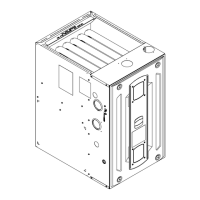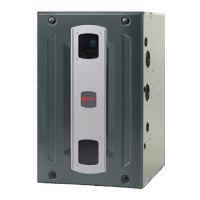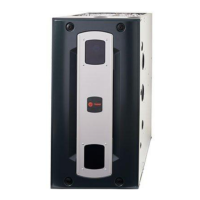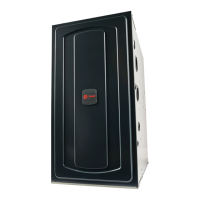42
S9V2-SVX001-1A-EN
Vent Terminations
For DDIIRREECCTT VVEENNTT AAPPPPLLIICCAATTIIOONN:: The Furnaces must
be vented to the exterior of the house and combustion
air MUST come through the inlet air pipe from
OUTSIDE AIR.
NNoottee:: BAYVENT* accessories can be used for inlet and
outlet terminals when the pipes do not exit the
structure together. For Canadian applications,
venting systems must meet ULC-S636
requirements.
For NNOONNDDIIRREECCTT VVEENNTT AAPPPPLLIICCAATTIIOONN:: The Furnace
shall be vented to the exterior of the house, but
combustion air may enter from the surrounding area as
long as combustion air requirements are met. (See AIR
FOR COMBUSTION AND VENTILATION)
VVeenntt tteerrmmiinnaattiioonnss
• BAYVENT200B
• BAYAIR30AVENTA
Vent terminations — Canadian applications. Meets
ULC-S636 requirements.
• BAYVENTCN200B
• BAYAIR30CNVENT
FFUURRNNAACCEE VVEENNTT // IINNLLEETT PPIIPPEE IINNSSTTAALLLLAATTIIOONN IINN
TTWWOO PPRREESSSSUURREE ZZOONNEE CCOONNFFIIGGUURRAATTIIOONNSS AARREE
NNOOTT AALLLLOOWWEEDD
NNoottee:: For single pressure zone applications, see the
Horizontal Venting section.
The following are EEXXAAMMPPLLEESS OONNLLYY..
EEXX.. 11 --
Example 1 shows the vent pipe exhausting through the
roof and the inlet air coming from the interior of the
house. The inlet air coming from the interior of the
house must meet combustion requirements for area,
etc., as shown in the section AIR FOR COMBUSTION
AND VENTILATION in this document.
NNoottee:: If only the flue gas pipe is to the outside of the
structure, a straight section of pipe (long enough
to exit the Furnace cabinet) must be attached to
the inlet air side with an elbow (which is 5 to 10
equiv. ft.) installed on the end to prevent dust
and debris from falling directly into the Furnace.
EEXX.. 22 --
The inlet air does not have to come from outside the
structure. Example 2 shows the inlet air, may come
from the attic if the requirements for combustion air
are met as shown in the section AIR FOR
COMBUSTION AND VENTILATION.
NNoottee:: If only the flue gas pipe is to the outside of the
structure, a straight section of pipe (long enough
to exit the Furnace cabinet) must be attached to
the inlet air side with an elbow (which is 5 to 10
equiv. ft.) installed on the end to prevent dust
and debris from falling directly into the Furnace.
Furnace
Air
Inlet
Vent
Attic
Vent
(See Note)
Attaching Vent Piping
VVEENNTT FFIITTTTIINNGG MMAATTEERRIIAALL –– PPLLAASSTTIICC
Gas and liquid tight single wall vent fittings, designed
for resistance to corrosive flue condensate, MUST be
used throughout.
Listed in the Approved Vent Pipe Materials table are
designations for different types of 2" and 3" size pipe
and fittings that meet these requirements. The
materials listed are various grades of PVC, CPVC, ABS,
PolyPro® by DuraVent , Z-Dens by Novaflex Group,
Innoflue® by Centrotherm, ECCO™ polypropylene
venting system, and PolyFlue™ polypropylene venting
systems.
IImmppoorrttaanntt:: Products installed in Canada must use vent
systems that are certified to the Standard
for Type BH Gas Venting Systems (ULC
S636) for Class II-A venting systems (up to
65°C). Components of the vent system
must not be interchanged with other vent
systems or unlisted pipe or fittings. Plastic
components, specified primers, and glues
must be from a single system manufacturer
and not intermixed with other system
manufacturer's vent system parts. In
addition, the first three feet of the vent pipe
must be visible for inspection.
FFuurrnnaaccee GGeenneerraall IInnssttaallllaattiioonn

